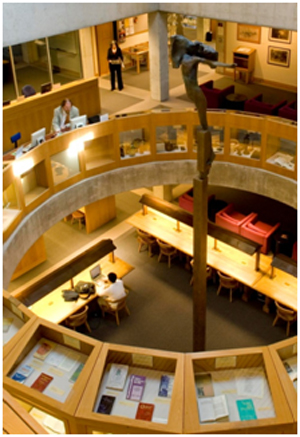Arthur Holder
Interreligious Education
Responding to the changing landscapes of the academy and the wider society, the Graduate Theological Union has created an innovative approach to doctoral education that features new opportunities for interdisciplinary scholarship and interreligious conversation.
The new doctoral curriculum represents another step in the GTU’s evolution toward becoming more fully interreligious. When the GTU was established in 1962, its faculty was entirely Christian, and all the doctoral students were studying some aspect of Christianity. That began to change in 1968 with the appointment of a professor in Jewish Studies, and then in 1971 as some students were admitted to work in the field of comparative religion.
 An inside view of the GTU library. – Photo: GTU
An inside view of the GTU library. – Photo: GTU
Further strides came with the affiliation of the Institute of Buddhist Studies in 1985, the opening of the Center for Islamic Studies in 2007, and the establishment of the Hindu Studies Initiative early in 2015. But despite this growing interreligious diversity, the doctoral program has largely continued to reflect the shape of the traditional Christian seminary curriculum.
In addition, the doctoral program has been organized according to areas of study that functioned largely independently of one another. The names of the areas have changed over the years, with new areas being added and others closing.
This familiar structure has served the GTU and its students well, but it had some limitations. Faculty with multiple fields of expertise have had to choose one or at most two areas in which they could advise students. With each area offering its own set of required courses, seminars were often too small to foster a robust exchange of ideas. Students could choose to study an allied field outside their own area, but doing so might require them to take additional courses and even an additional comprehensive exam. Perhaps most importantly, students and faculty studying religions other than Christianity were usually grouped together in isolation, even though they were using many of the same methodologies as their colleagues working on topics in Christianity.
Facilitating Interreligious Collaboration
In the future, the doctoral program will feature more than thirty concentrations, grouped into four interdisciplinary departments, each designed to allow greater opportunity for interreligious collaboration. The new curriculum will retain all of the fields existing in the current doctoral program, but will also include a host of new additions such as Qur’anic Studies, Religion and Literature, Hindu Theology, and Practical Theology.
Suzanne Miller, a member of the GTU Student Advisory Committee that helped shape the new curriculum, says she is “extremely excited” about the new direction. “Even as our world becomes increasingly interreligious, it is easy for scholars in more traditional Christian disciplines to remain isolated from, or even avoid, interreligious study and dialogue. As a doctoral student in biblical studies, I am keenly aware of my need to participate in conversations with other religious traditions, particularly about their approaches to their sacred texts. I am encouraged by the ways the new curriculum deliberately incorporates areas of study that are typically Christian into a wider interreligious dialogue.”
As of fall 2016, doctoral students will take an introductory course on methods in the study of religion, a course on the art of teaching, and an interdisciplinary departmental seminar. These courses will help each entering class of doctoral students form a cohort of colleagues, and hopefully friends. Each student will work with a faculty advisor with expertise in the primary concentration to design an approach to additional course work at the GTU, the University of California, Berkeley, and other Bay Area schools.
If you know someone who might be interested in theological and religious studies at the graduate level, please let them know that a great program is going to be even better in the future. The GTU’s new doctoral program will be ready for them in 2016!
This article first appeared in the Fall 2015 issue of Currents, published by the GTU.
